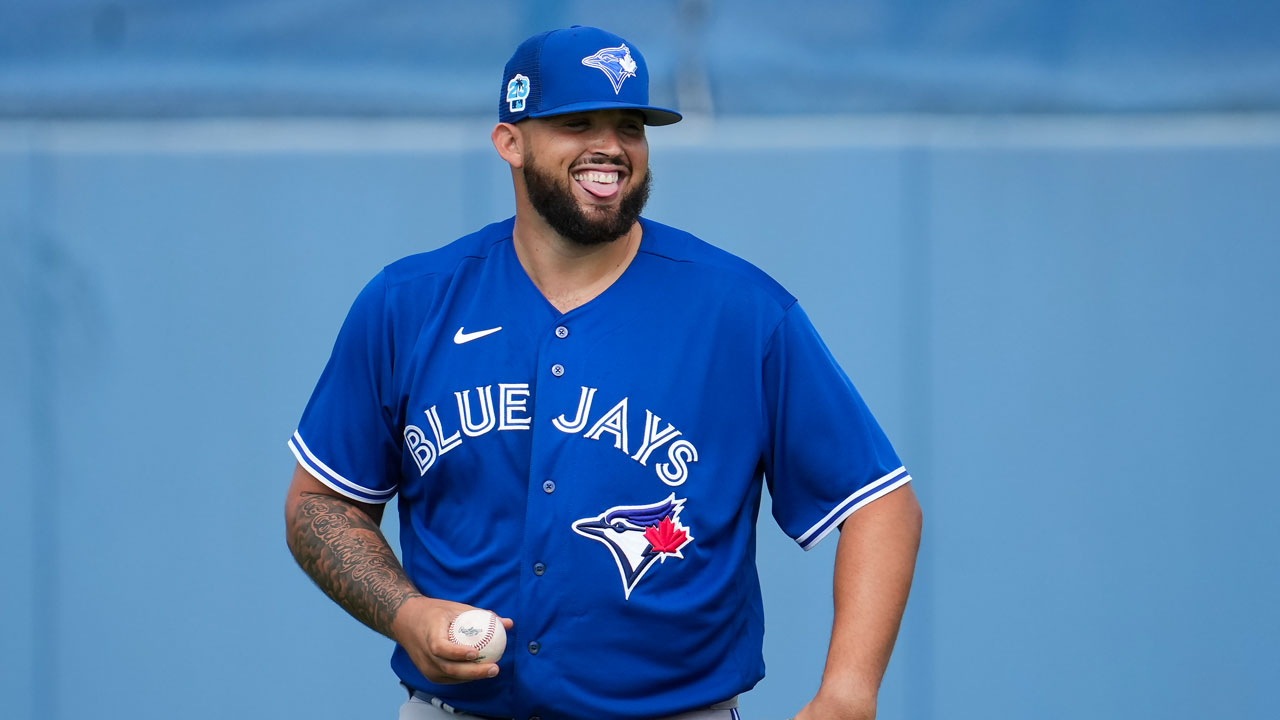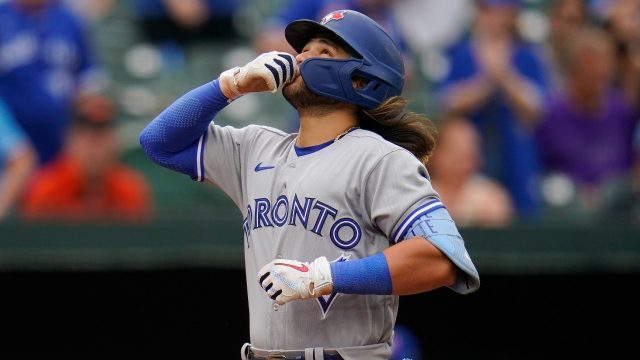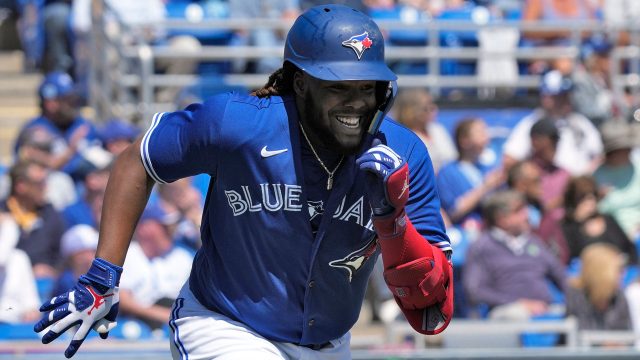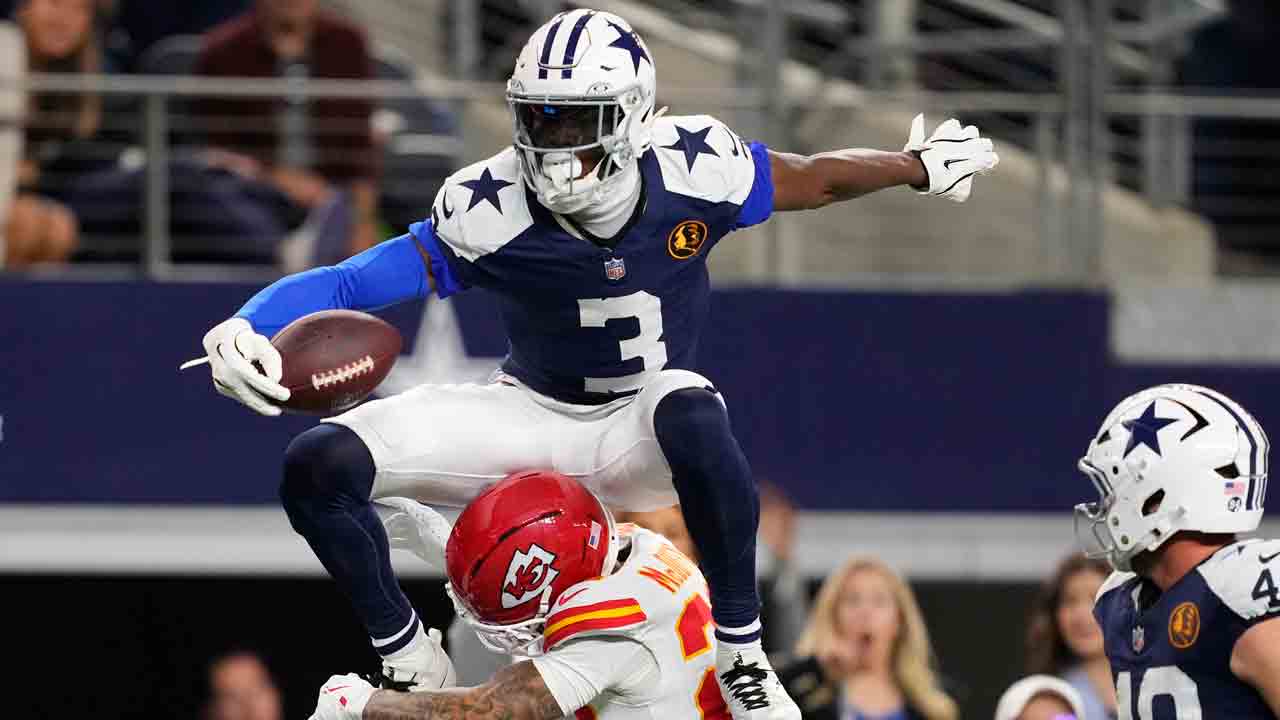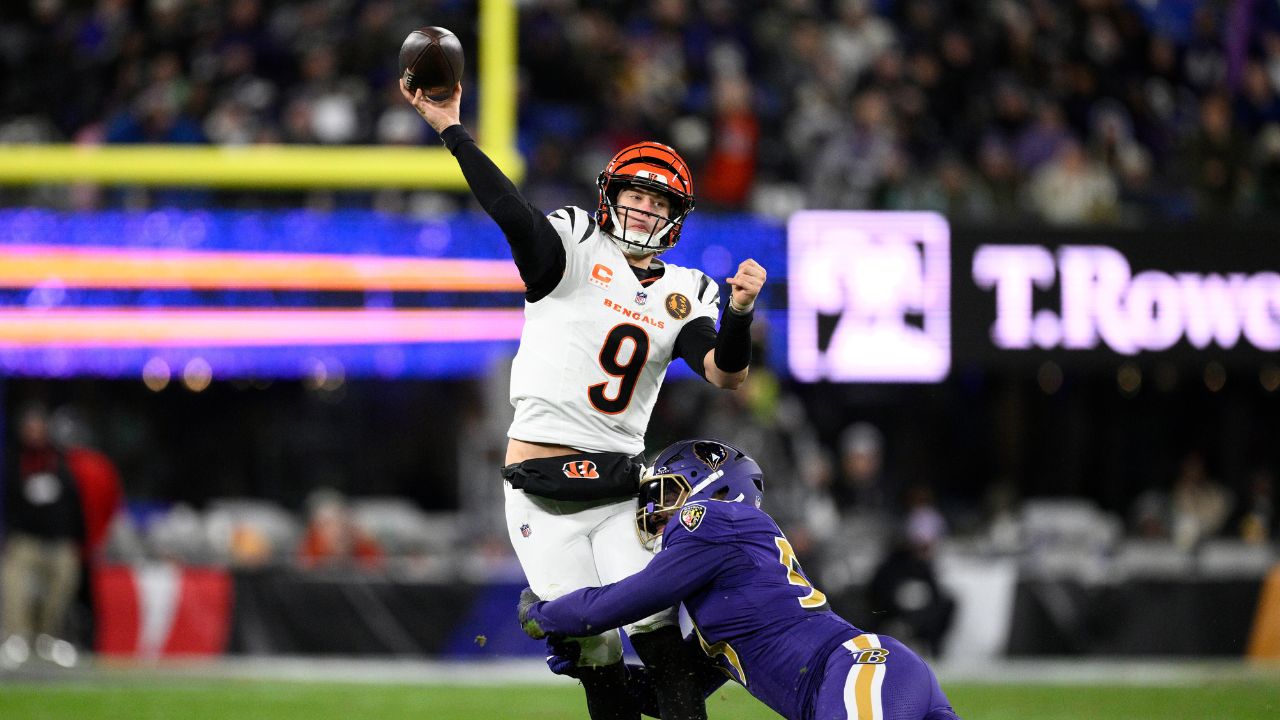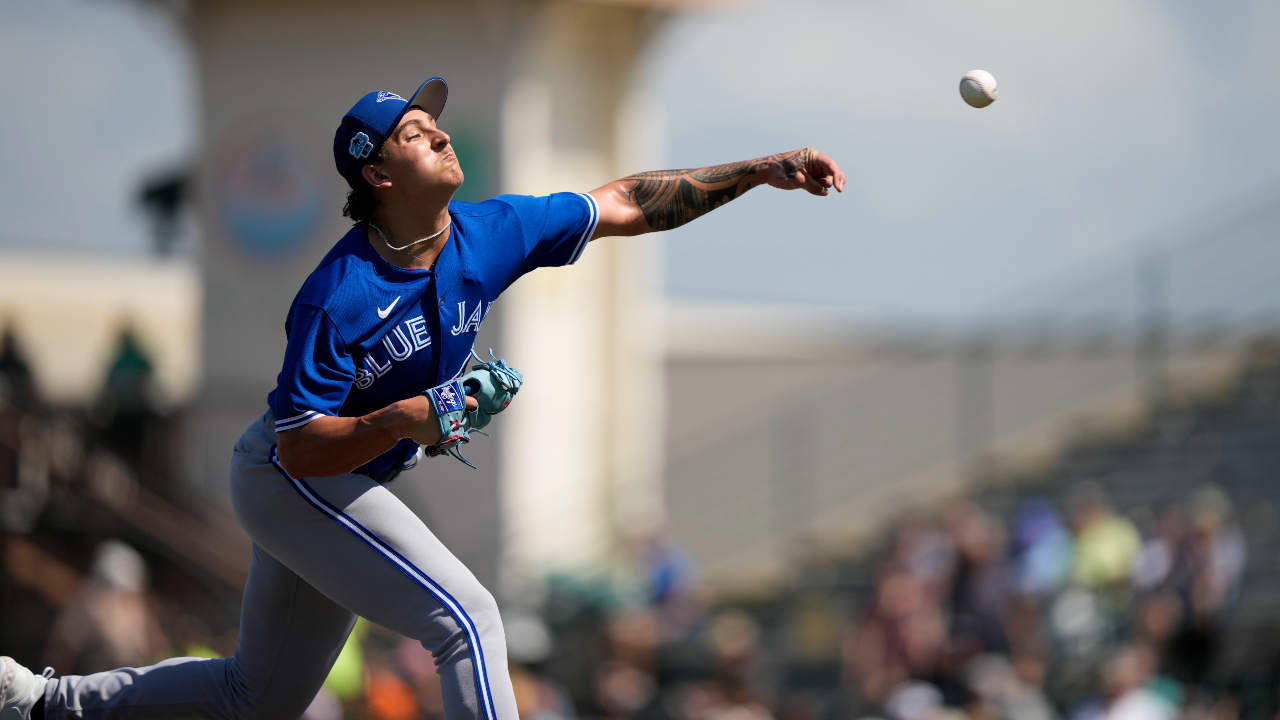
Ricky Tiedemann has gone from one of the biggest stories at Toronto Blue Jays camp to a pitcher shut down due to shoulder soreness and shuffled off to minor-league camp in a couple of weeks.
That’s not an indictment on the southpaw in the slightest. His absence from game action is still being described as precautionary and a 20-year-old with 11 career innings above class-A can’t reasonably be expected to make the big-league team.
Even so, it seems that Blue Jays’ top prospect is on a trajectory that could have him logging MLB innings before 2023 is done. After the team allowed Alek Manoah to debut after pitching just 35 minor-league frames, it’s easy to envision Tiedemann enjoying a similar rapid ascent.
As a rule of thumb, comparing pitching prospects to Manoah is a recipe for disappointment, though – and his situation was less similar to Tiedemann’s than it seems on the surface.
Manoah was 23 when he debuted with the Blue Jays and his minimal minor-league track record was bolstered by 241.1 college innings, plus an opaque workload at the team’s complex during the cancelled minor-league season in 2020.
Tiedemann, on the other hand, has 78.2 pro innings to his name, buttressed by nothing more than 38 frames for Golden West College. He’s also entering his age-20 season. Plenty of solid prospects aren’t even sniffing double-A at Tiedemann’s age, let alone looking at a possible MLB debut.
The southpaw is special, but when contemplating what lies ahead for him in 2023, it’s worth understanding how little precedent exists for deploying pitchers his age in the history of the Blue Jays.
Just five pitchers have appeared for the Blue Jays in their age-20 or younger season, and a look at those situations shows just how unusual Tiedemann will be if he’s able to break through this season:
Jeff Byrd
Season: 1977
How he did: 6.18 ERA and 4.90 FIP in 87.1 IP (17 starts) for 0.3 fWAR
What happened next: Not a lot for Byrd.
After his rough showing as a rookie, Byrd was demoted to triple-A in 1978 and cut during spring training in 1979. He spent his last professional season playing for the Seattle Mariners’ class-A affiliate, and his baseball career was done before his 23rd birthday.
Anything to learn?: It’s easy to see that Byrd’s rookie season came in 1977 and assume that this is a situation where Toronto simply rushed a pitcher to the majors because they were desperate for talent.
That’s true to an extent, but Byrd was surprisingly experienced at the minor-league level before his Blue Jays debut, with 400 pro innings under his belt.
Instead, this was an example of a pitcher earning a look because of good results despite disastrous peripherals. Byrd had a 4.14 ERA in his minor-league career before joining Toronto, including a 3.13 mark in 10 double-A starts in 1977 before he got the call.
However, he also had a BB/9 of 6.46 and K/9 of 5.94 in the minors. That statistical profile foretold disaster, and a pitcher posting numbers like that simply wouldn’t earn a promotion today.
The chances of Tiedemann performing like Byrd did in the minors is virtually non-existent, and if he did, the Blue Jays would leave him to sort himself out. There’s no risk of the club making the same mistake it did in its first season.
Victor Cruz
Season: 1978
How he did: 1.71 ERA and 2.71 FIP in 47.1 IP (9 saves) for 1.2 fWAR
What happened next: Cruz went on to have a productive, if relatively brief, career as an MLB reliever. He retired having logged 271 innings at the highest level across five seasons with a 3.09 ERA.
After his stellar rookie season, the Blue Jays traded Cruz for Alfredo Griffin and Phil Lansford.
Anything to learn?: Calling on Cruz early worked out well for the Blue Jays, as they got a productive season out of him and moved him for someone who they used as an everyday player.
When Toronto acquired Cruz from the St. Louis Cardinals before the 1978 season, they immediately converted him to a reliever and saw him perform well enough in triple-A to earn a call to the big club in June.
Tiedemann’s ceiling is too high for him to receive similar treatment, but the Cruz case reinforces the notion that even extremely young pitchers can be well-suited to high-leverage relief roles in the majors.
The Blue Jays’ current top prospect might find himself pitching out of the bullpen for the big-league club later in the season as a way of introducing him to the MLB level and limiting his innings.
Roberto Osuna
Season: 2015
How he did: 2:58 ERA and 3.02 FIP in 69.2 IP (20 saves) for 1.3 fWAR
What happened next: Osuna was one of MLB’s most reliable closers between 2015-19. The Blue Jays traded him shortly after he served a 75-game suspension for violating MLB’s domestic violence policy.
His MLB career came to an end in 2020 after he opted not to get a second Tommy John surgery, and he currently plies his trade in Japan.
Anything to learn?: Starting Osuna out in a relief role in 2015 was controversial as he had the repertoire to start, but he had also logged no more than 43.2 innings in any of his pro seasons, so building up to a starter’s workload would’ve taken years.
The Blue Jays got great on-field results from rushing Osuna along in a relief role – and the team needed stability in the bullpen after its relief corps ranked 23rd in fWAR with MLB’s sixth-worst ERA.
There’s an argument to be made that Toronto mishandled Osuna based on its needs at the time and robbed itself of a future starter, but it’s impossible to know if that’s the case.
Osuna, like Cruz, is an example of a pitcher thriving in a prominent bullpen role despite his youth, but his development path probably isn’t a good model for Tiedemann.
Miguel Castro
Season: 2015
How he did: 4:38 ERA and 4.76 FIP in 12.2 IP (4 saves) for -0.1 fWAR
What happened next: The Blue Jays included Castro in their trade for star shortstop Troy Tulowitzki, and he’s been a steady middle reliever in the majors since 2017. The right-hander has produced a 4.12 ERA across 371.1 innings with five teams over eight MLB seasons.
Anything to learn?: Castro’s case was comparable to Osuna’s in a number of ways.
For instance, on FanGraphs Blue Jays prospect list for 2015, he ranked sixth while Osuna ranked seventh and they were both given the same role projection (No. 4 starter/closer) with very similar anticipated paths to the big leagues as starters by 2017.
Although Osuna provides a powerful example of instant success residing within the realm of outcomes for young pitchers, Castro has a different lesson to teach.
The right-hander had a tough time with the Blue Jays as a rookie and couldn’t establish himself as a big leaguer with the Colorado Rockies, either. It took Castro finding his third organization (the Baltimore Orioles) before he achieved consistent success.
When a young pitcher’s debut doesn’t go as planned, it doesn’t necessarily mean their confidence is shot or their development is broken, they might just need a little time. Castro found his groove after a bumpy start and now he’s carving out a solid MLB career.
Elvis Luciano
Season: 2019
How he did: 5:35 ERA and 5.56 FIP in 33.2 IP (0 starts) for -0.2 fWAR
What happened next: After spending most of his rookie season sitting in the bullpen waiting for uncompetitive situations, he then had his 2020 campaign wiped out by COVID.
The right-hander made 14 starts at the double-A between 2021 and 2022, missing most of the latter season with a stress fracture in his arm. He elected free agency in December.
Anything to learn?: In a word, no.
This was a bizarre situation where the Blue Jays hoped to use the fact they had no intentions of competing in 2019 to nab a pitching prospect through the Rule 5 Draft and stash him in the bullpen all year.
Luciano rarely pitched, and when he did it usually wasn’t pretty. He wasn’t ready for the majors, which is fair because he was 19 and had no experience above rookie ball before 2019.
After a forgettable rookie year, Toronto hoped to begin developing Luciano in the minors in earnest, but that never panned out.
There is a difference between creative and effective team building, and the Blue Jays’ capacity for thinking outside the box didn’t bear fruit in this case.
What about the 21-year-olds?
If we expand out Tiedemann’s peer group by a year, we find a couple of pitchers in Blue Jays’ history whose paths more closely mirror his own:
Dave Stieb entered 1979 with just 26 pro innings, but he pitched 51 frames at both class-A and triple-A before getting the call in June 1979. He never looked back.
Brandon Lyon came into 2001 with 60.2 pro innings at low-A and made 20 starts at double-A and triple-A before earning a promotion in August. He flamed out as a starter, but had a 12-year MLB career as a reliever.
Moving the sample up by a year yields only 14 more results, though. Finding Blue Jays pitchers on the trajectory Tiedemann finds himself on is tough.
The southpaw is no lock to make his major-league debut this year, but it’s an outcome that wouldn’t be remotely surprising based on what we’ve seen from him so far. If he’s able to crack the Blue Jays roster, it will be an impressive achievement that has few parallels in franchise history.


